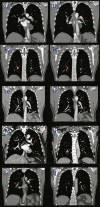Late acute pulmonary embolism after mild Coronavirus Disease 2019 (COVID-19): a case series
- PMID: 32901760
- PMCID: PMC7477961
- DOI: 10.1590/S1678-9946202062063
Late acute pulmonary embolism after mild Coronavirus Disease 2019 (COVID-19): a case series
Abstract
In late 2019, the severe acute respiratory syndrome coronavirus 2 (SARS-CoV-2) emerged as the cause of a cluster of pneumonia cases in China, and the corresponding disease was designated as Coronavirus Disease 2019 (COVID-19), spreading quickly around the world resulting in a pandemic. COVID-19 is associated with a set of coagulation abnormalities that increase the risk of thromboembolic events, especially in patients with severe/critical disease. We describe a series of five cases of mild COVID-19, treated in an outpatient clinic, which, after an apparent clinical improvement, developed acute pulmonary embolism (APE) between the third and the fourth week after the onset of symptoms, when they are mostly related to acute illness disappearance. Thromboembolic events are also a potential complication of mild COVID-19 and can manifest later in the disease course. This finding raises discussion about the prevention of thromboembolic events in selected group of patients with mild COVID-19.
Figures

Similar articles
-
Acute pulmonary embolism: An unseen villain in COVID-19.Indian Heart J. 2020 May-Jun;72(3):218-219. doi: 10.1016/j.ihj.2020.05.003. Epub 2020 May 16. Indian Heart J. 2020. PMID: 32425236 Free PMC article. No abstract available.
-
Large saddle pulmonary embolism in a woman infected by COVID-19 pneumonia.Eur Heart J. 2020 Jun 7;41(22):2133. doi: 10.1093/eurheartj/ehaa402. Eur Heart J. 2020. PMID: 32374381 Free PMC article. No abstract available.
-
ST-elevation myocardial infarction and pulmonary embolism in a patient with COVID-19 acute respiratory distress syndrome.Eur Heart J. 2020 Jun 7;41(22):2134. doi: 10.1093/eurheartj/ehaa399. Eur Heart J. 2020. PMID: 32374405 Free PMC article. No abstract available.
-
Malignant Cerebral Ischemia in A COVID-19 Infected Patient: Case Review and Histopathological Findings.J Stroke Cerebrovasc Dis. 2020 Nov;29(11):105231. doi: 10.1016/j.jstrokecerebrovasdis.2020.105231. Epub 2020 Aug 5. J Stroke Cerebrovasc Dis. 2020. PMID: 33066910 Free PMC article. Review.
-
Thromboembolic events and Covid-19.Adv Biol Regul. 2020 Aug;77:100735. doi: 10.1016/j.jbior.2020.100735. Epub 2020 Jun 17. Adv Biol Regul. 2020. PMID: 32773098 Free PMC article. Review.
Cited by
-
An oral combined contraceptive user with elevated D-dimer post COVID-19: a case report.BMC Womens Health. 2021 Aug 28;21(1):320. doi: 10.1186/s12905-021-01456-5. BMC Womens Health. 2021. PMID: 34454488 Free PMC article.
-
Thromboprophylaxis strategies to improve the prognosis of COVID-19.Vascul Pharmacol. 2021 Aug;139:106883. doi: 10.1016/j.vph.2021.106883. Epub 2021 Jun 4. Vascul Pharmacol. 2021. PMID: 34091065 Free PMC article. Review.
-
Right Ventricular Clot in Transit in a Patient with Coronavirus Disease 2019 (COVID-19) Pneumonia Successfully Treated with Thrombolytics.Case Rep Crit Care. 2022 Jul 5;2022:3483605. doi: 10.1155/2022/3483605. eCollection 2022. Case Rep Crit Care. 2022. PMID: 35811832 Free PMC article.
-
Post-COVID syndrome: pulmonary complications.Turk J Med Sci. 2021 Dec 17;51(SI-1):3359-3371. doi: 10.3906/sag-2106-238. Turk J Med Sci. 2021. PMID: 34284532 Free PMC article. Review.
-
The Prevalence of Previous Coronavirus Disease-19 in Patients with Pulmonary Thromboembolism and Its Effect on Embolism Severity.J Clin Med. 2025 Mar 12;14(6):1909. doi: 10.3390/jcm14061909. J Clin Med. 2025. PMID: 40142721 Free PMC article.
References
-
- World Health Organization Novel Coronavirus (2019-nCoV): situation report - 1. Jan 21, 2020. [cited 2020 Aug 12]. https://www.who.int/docs/default-source/coronaviruse/situation-reports/2....
-
- World Health Organization Coronavirus disease 2019 (COVID-19): situation report - 51. [cited 2020 Aug 12]. https://www.who.int/docs/default-source/coronaviruse/situation-reports/2....
-
- World Health Organization Novel Coronavirus (2019-nCoV): situation report - 22. [cited 2020 Aug 12]. https://www.who.int/docs/default-source/coronaviruse/situation-reports/2....
-
- World Health Organization Coronavirus disease (COVID-19): situation report - 197. [cited 2020 Aug 12]. https://www.who.int/docs/default-source/coronaviruse/situation-reports/2....
-
- World Health Organization Clinical management of severe acute respiratory infection (SARI) when COVID-19 disease is suspected: interim guidance. [cited 2020 Aug 12]. https://apps.who.int/iris/bitstream/handle/10665/331446/WHO-2019-nCoV-cl....
Publication types
MeSH terms
LinkOut - more resources
Full Text Sources
Medical
Research Materials
Miscellaneous

